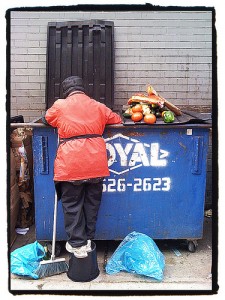What would you take with you if you had to evacuate in a short period of time? Not an easy decision, you say? You would be right.
In 2003 we were living in an area where there was fire raging in the foothills to the north, and a lesser but nevertheless wildfire in the hills behind us. Jerry was then volunteering with the San Bernardino Sheriff's "Citizens on Patrol (COP)" program and was going door to door with them near the big fire announcing mandatory evacuations. To be honest with you, neither fire was threatening us, but the one behind me was making me nervous.
Although we had always had a major 'Earthquake' supply storage container in our back yard in Orange, and a suitcase full of supplies and clothing in the trunks of our cars to hold us over if an earthquake hit while we were at work, when we retired we had no place to store such supplies. This 2003 fire made me think about what I would grab if I had to immediately evacuate the apartment while Jerry was gone.
The picture above is what I came up with. (If you click on it you can read the notations better.) I would grab a few items of clothing and throw them over around my neck. I would chuff all the small stuff like cell phone, wallet, jewelry, etc. in my purse and that could hang over an arm. I would chuck the CPU under my left arm, grab the photo albums, baby books, bible, etc. in the other arm. Tigger and Cipsi, our two cats, would go into their crates and since I had no more hands, I would have to push them along in front of me while I got the heck out of there!
Yes, this made me laugh, but it wasn't so far from the truth. At least at that time it made me identify what for sure I counted important.
Things have changed since then. Since my computer is backed up to my son's server, a thumb drive, and the cloud, I wouldn't have to lug the big CPU. Throw the program CDs in my purse and that's that! Add in my new iPod. Most of the albums have now gone out to the kids. And my supply of books I can't live without is being routinely thinned. And the only cat left is a new cat, Squeaky.
Now why is it that I am bringing this all up?
The senior complex where we live is very large. There are 140 acres of property, on which some 90 residential buildings sit. They are scattered willy-nilly over the area. Each building looks like a military bunker -- a rectangular one-story building. Each building contains 14 apartments - 6 on each side and one tiny studio apartment on each end. Our county is working on a Disaster Management Plan and has chosen our development as the guinea pig. Their thinking is that if they can make their plan work here they then can broaden and refine it for the rest of the county residents.
A couple of weeks ago all the residents were invited to a meeting put on by the county Disaster Management group to introduce this plan to us. Believe it or not, it was about the most interesting thing I've listened to in a long, long time...so interesting, in fact, that in a series of blogs, I'll share with you some of the ideas presented that each of us, living in today's scary world, should know.
The presenter asked us to think about the difference between an
Emergency and a
Disaster. She said the answer was simple and clear: in an Emergency you dial 911 and get a response from either the police, the fire department, the utility company or other organization. In a Disaster, there probably will be no phone service, either cellular or otherwise, to begin with, and even if you should be able to phone, there will be no one available to respond to your need for help because of the magnitude of the event.
You will have to be the help for yourself and for others.. The disaster might be an earthquake, a fire, an airplane crash (we are in the takeoff path of airplanes flying out of Ontario), or even, say, a dirty bomb.
This lady made us realize that disaster preparedness is not simply a matter of grabbing a few things and evacuating. So what to do?
























